Last Updated on April 5, 2024
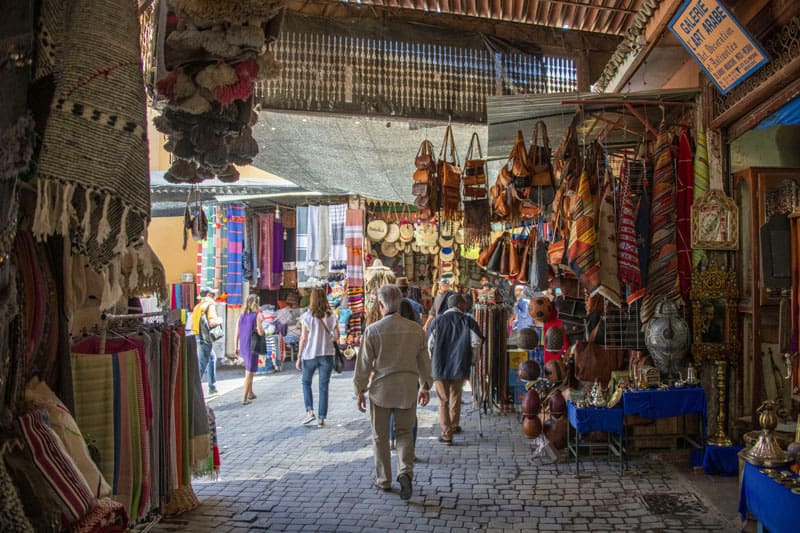
I first visited exotic Marrakesh several decades ago. On my return recently, though, I found things really haven’t changed all that much…
Estimated reading time: 16 minutes
Undated for 2023
By Jim Ferri
I love the movie Casablanca, that iconic film set in World-War-II Morocco.
It’s a wonderful film, but somewhere in the transition from Bogart to Boeing, Morocco changed.
20th Century-Fox fantasies have metamorphosed into a 21st-century aggregation of luxury hotels, tourists, and traffic lights.
Casablanca is now large and modern. Tangiers, closest to Europe, is now a hybrid that it has little left in common with the rest of the country. And piratic Rabat, once the lair of buccaneers, now harbors only bureaucrats.
There is, however, one Moroccan city that has managed to retain some semblance of its cultural past.
That oasis on today’s desert of modernization is Marrakesh.
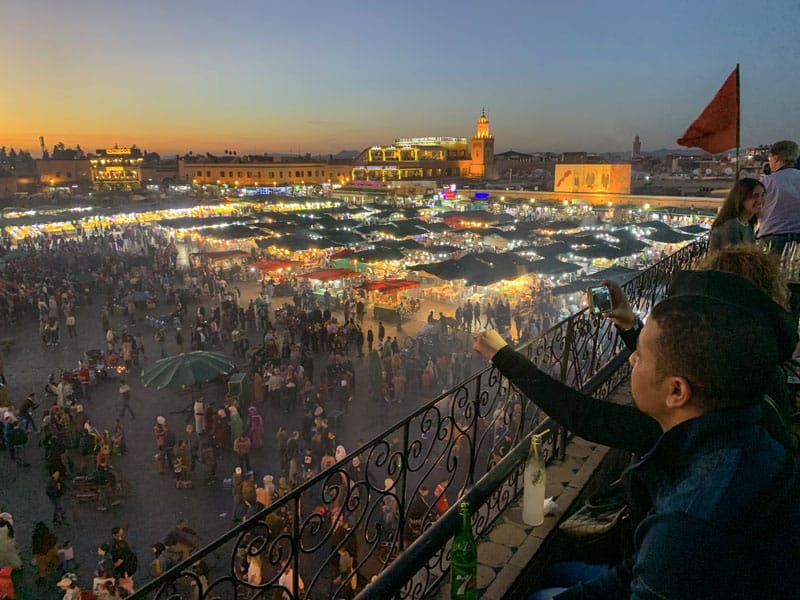
Revisiting Marrakesh
I had been to Morocco decades ago and recently returned.
I found the country modernized with better roads (now carrying a multitude of motorbikes), and modern airports (welcoming more travelers than ever before).
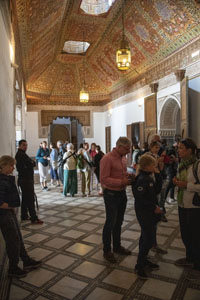
Along with this influx of tourists, there is also an influx of hotels and related structures. This has changed most of Morocco’s cities’ faces and cultures as they succumbed to the onset of urban sprawl.
The exception to all of this is Marrakesh, which has survived intact. It is still much like it was many centuries ago because its Medina, its huge old city, is protected by a massive 12½ mile long, 33 ft high wall. And everything within it has been saved as well.
Yes, there’s been a hotel boom in Marrakesh’s Medina, but the modernization of existing hotels – called Riads and Dars – has only taken place in the interior of all the buildings.
All of Marrakesh’s car-less streets, narrow lanes, and web of walkways in its souks remain just as they had been during my earlier visit as well as many hundreds of years before that. Walk through the Medina today, and you’re still literally walking through Marrakesh in medieval times. And today you’ll still find lots of things to do in Marrakesh, one of the top places to visit in Morocco. Go outside the city and you can even go camel trekking in the Sahara.
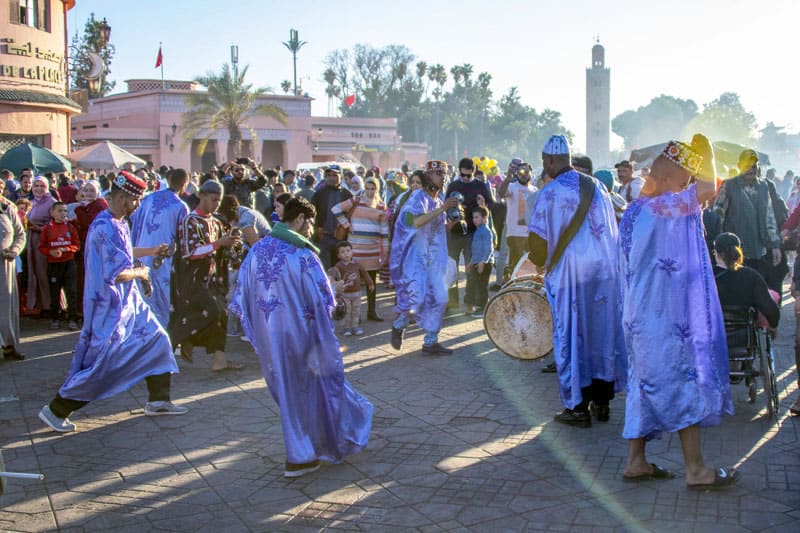
The Top Thing to Do in Marrakesh: Experience the Jemaa-el-Fna
The very center of town is the Jemaa-el-Fna, the so-called “Assembly of the Dead,” which, despite its macabre name, is the country’s liveliest place. Its name was bestowed by a governor in 1050 AD who enjoyed beheading captured rebels in the town square as people looked on, a not-so-subtle warning to potential insurrectionists.
The vast square is only a 10-minute walk east of the 12th-century, Koutoubia mosque, which is open only to Muslims. Its 230-foot minaret, much taller than any building in the Medina, is the reason it’s so prominent in many photos of the square.
Head to Jemaa-el-Fna and you’ll find storytellers, dancers, beating drums, snake charmers, Berber musicians, medicine men, henna tattoo artists, etc., and more food stalls than you’ve seen anywhere. It’s the most colorful and lively sideshow in all of North Africa, if not the world.
It’s this assemblage – not the Jemaa el-Fna itself – that is the UNESCO World Heritage Site. UNESCO declares it a “Masterpiece of World Heritage” for its intangible cultural heritage. See for yourself, snake charmers and all.
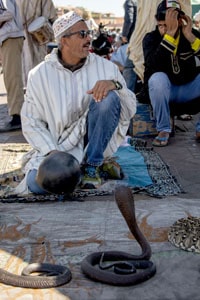
Plan to go mid- or late afternoon to be able to walk about, perhaps have a bite to eat and look at the performers and scarlet-clad water sellers and everything else before the crowds start filling the square right before sunset. It’s at this time that the noise and the action in the square reaches a crescendo.
However, keep in mind that everything you do in the Jemaa el-Fna – watching the feverish dancers, taking photos of the water sellers or snake charmers, or anyone (be sure to ask permission first) – will have a cost attached. So have a few dirhams ready and, of course, watch out for pickpockets.
The best place to view the Jemaa el-Fna and the entire evening spectacle is from one of the Hôtel Restaurant Café de France’s upper floors on the square’s eastern edge.
The table’s price is only a drink, even just a Coke, but it will give you a good vantage point as the crowd around you grows. It’s best to go early in a small group, so some can hold the table while others go down below to wander about through the circus. Just don’t expect good food or service.
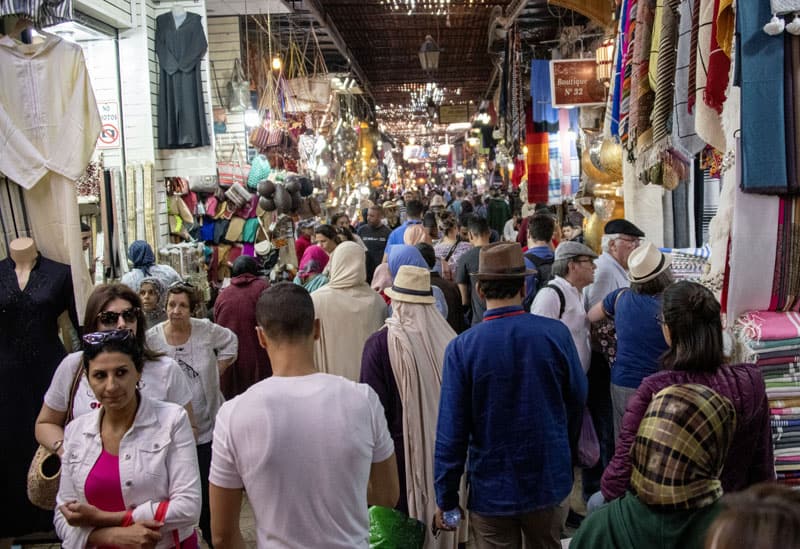
Another Thing to Do in Marrakesh: Visit the Medina
A vast and crowded labyrinth of streets, Marrakesh’s Medina is fantastic. It’s the oldest section of the city and the part least touched by modernity.
Today it’s still the place where you’ll find medieval merchants in cave-like souks, a whirlwind of color, and a thousand animated djellabas. All about are towering piles of leather and wool, sandalwood and cedar, tin and copper. From clothing and shoes to lamps and copper pots, if it’s Moroccan, you’ll find it here.
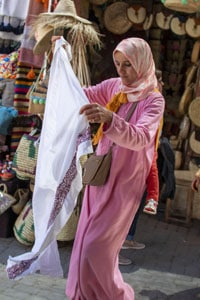
The Marrakesh Medina is timeless, and still the same as when I traveled here decades ago, haggling with silver-tongued merchants with gold-toothed smiles. You’d only agree on a price after a long, patient, psychological battle of wits. And even then, you’ll likely feel you’ve probably been taken.
However, understand that this haggling is part of the culture and they expect it of you. Offer approximately half of the asked price initially, and as the merchant comes down, you edge up until you meet in the middle. Never accept the first price.
The best way to both see and survive the Medina – and the other important sites in the city – is with a tour guide. You’ll likely have trouble finding the sites otherwise (including finding your way through the Medina itself. In addition, you’ll have a fascinating private tour once you get to where you want to go.
We hired a guide for a six-hour walking tour of the city for 500 dirhams, approximately $50. It was money well spent.
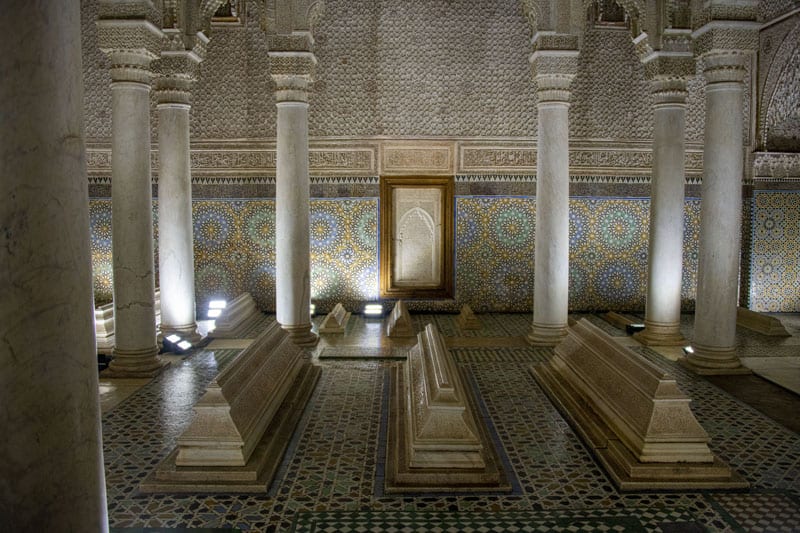
A Quick Visit to the Saadian Tombs
Our first stop with the guide was a short stop at the Saadian Tombs. If you want proof that you can take it with you, this is the place to go.
Dating to the Saadian Dynasty (16th-17th centuries), the tombs are the final resting places of Sultan Ahmad al-Mansur and other monarchy members. To prepare his royal necropolis, the Sultan imported marble from Italy and gilded the chamber’s decorative plaster work with gold.
A few decades after his death in 1603, another sultan walled up the tombs. They were forgotten for centuries until the French discovered them in 1917.
It’s a tranquil and beautiful spot, guarded by a phalanx of stray cats.
If you go:
Saadian Tombs
Rue de La Kasbah
Marrakesh 40000
Open: daily 9am–4:30pm
Admission: 10 dirhams
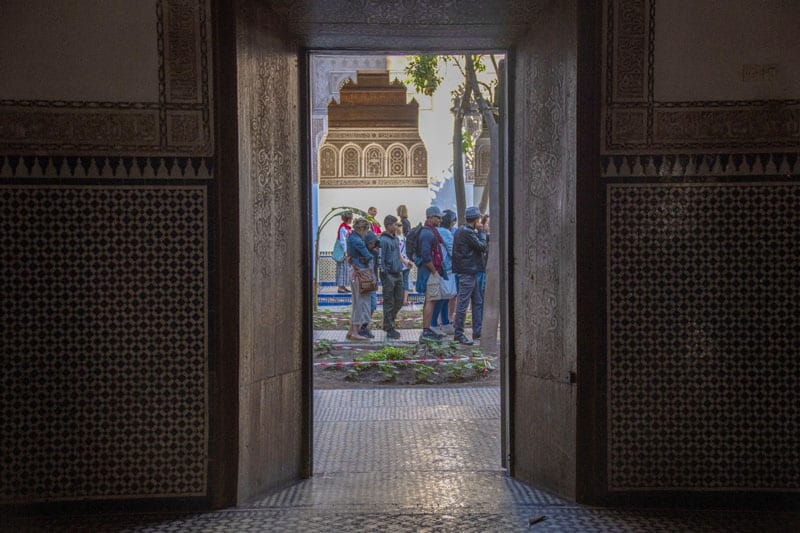
Don’t Miss Marrakesh’s Bahia Palace
After a 20-minute walk from the tombs, we arrived at Bahia Palace, constructed in the 1860s by the Grand Vizier, the government head under a sultan. However, the most significant part of the construction was undertaken by his son, the subsequent Grand Vizier.
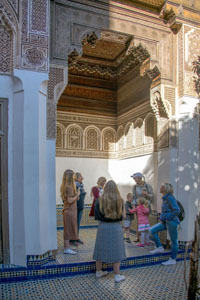
Their aim was to build the most fabulous palace in the world. The son also wanted to ensure there’d be sufficient room for his four wives and 24 concubines.
It is an extraordinarily beautiful place undertaken by a renowned Arab architect of the time, with the finest craftsmen in Morocco. This Marrakesh palace – all on one level – is filled with dazzling tile, colored glass, and intricate marquetry. The artisans mixed their plaster with marble powder for added strength and then carved it while wet.
Even the painted cedar ceilings are exquisite. Our guide explained that in one room for army officers, the ceiling is raised like a nomad tent and painted like the night sky to give the illusion of sleeping under the stars.
The palace, however, is totally empty. When the son died in 1900, the concubines looted the place before the Sultan took the remainder of the booty off to his palace.
Unfortunately, you see only a small portion of the original buildings and gardens on the 20-acre site. It is also still used occasionally by the current King of Morocco.
You don’t want to miss it.
If you go:
Bahia Palace
Avenue Imam El Ghazali
Marrakech 40000
Open: daily 9am–4:45pm
Admission: 70 dirham
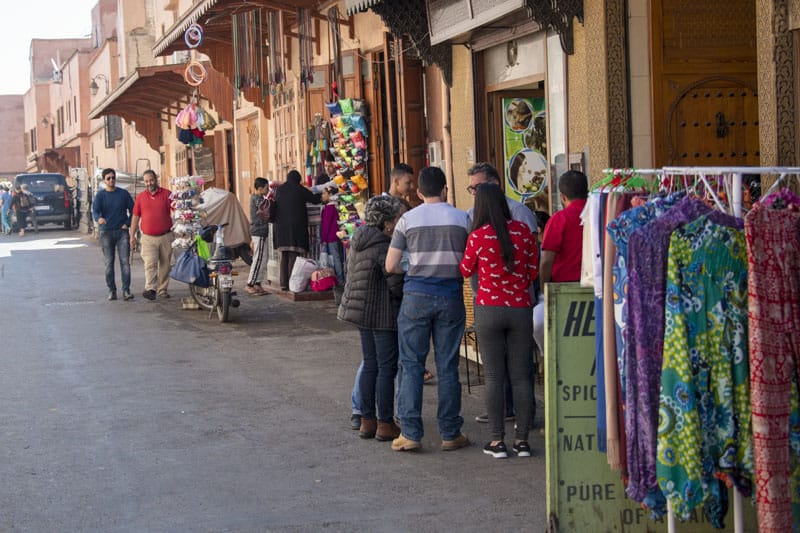
Jewish Quarter
You may think it unusual to have a Jewish Quarter in an Arab country. But that’s not the case in Morocco, which has a sizeable Jewish population.
The influx was likely a result of Jews and the Moors fleeing southward across the Strait of Gibraltar during the Spanish Inquisition.
Called the Mellah, you’ll find a Jewish Quarter in Morocco’s imperial cities (Fez, Marrakesh, Meknes, and Rabat). In Marrakesh, it’s near the Bahia Palace.
In fact, in each of the imperial cities, the quarter is near the palace for security purposes. It protected the Jews who sold gold and goods, and it also made tax collection easier.
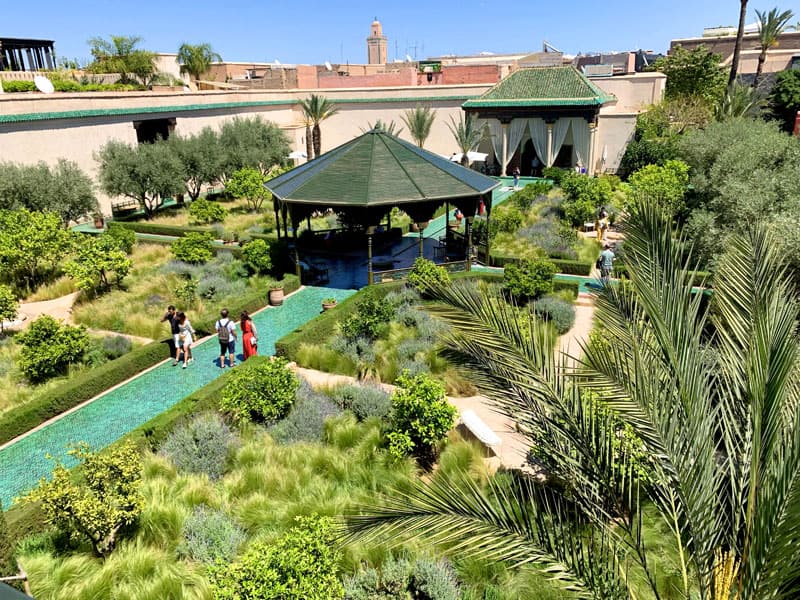
Secret Garden
Although this historic riad is centuries old, it’s not the building itself that makes it unique. What attracts visitors here is the “secret” garden, a traditional Islamic garden.
The garden is irrigated by an underground irrigation system (a” Khettara”) dating from the 11th century, which at one time provided water throughout the city. It was only discovered during the restoration of the riad.
The garden is a living garden museum that highlights the ancient water system. It is divided into two parts. One is an exotic garden, the other a traditional Islamic garden containing figs, dates, pomegranate, and olive trees.
On the second floor, there’s a small café, a good place to stop for a quick lunch or tea.
If you go:
Rue Mouassine 121,
Marrakesh Medina
[email protected]
Tel: +212(0)524 39 00 40
Open: February and October: 9.30 am – 6.30 pm / March to September: 9.30 am – 7.30 pm / November to January: 9.30 am – 6.00 pm.
Admission: Adults 80 dirhams / 7-24 years: 60 dirhams / 6 years and younger free
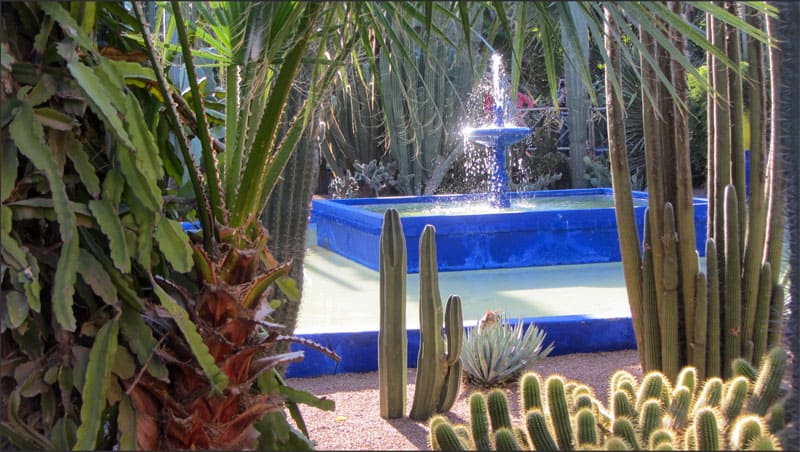
Ville Nouvelle and Gueliz, Marrakesh’s Modern Side
You’ll find a more popular garden in Ville Nouvelle, the city’s newer area, about a half-hour walk.
Marrakesh’s Ville Nouvelle (new town) is full of leafy parks, cafe culture, a thriving contemporary art scene, and the best bars, clubs and gourmet restaurants in town. And if you really crave a latte, there’s also a Starbucks.
Gueliz is the central shopping hub, where you’ll find fixed prices in stores and even a few chain stores in malls.
The most popular attraction in Ville Nouvelle (some claim in all of Morocco) is the Jardin Marjorelle. This trendy garden was owned by French-fashion-icon Yves Saint Laurent.
YSL bought it from landscape painter Jacques Majorelle to open it to the public. It has a colorful collection of plants from five continents, part of which Lonely Planet describes it as a “psychedelic desert mirage”.
As you might expect, considering the owner, it has a nice café and a chic boutique. Adjacent to it is the Musée Yves Sant Laurent. You can buy a combination ticket for both.
If you go:
Jardin Marjorelle
Rue Yves St Laurent
Marrakech 40090
Tel: +212 5 24 29 86 86
Open: Monday – Sunday 9am – 6 pm
Admission: Garden 70 dirhams, Museum 30 dirhams / Foreign university students: Garden: 35 dirhams; Museum: 25 dirhams / Children under 12 years old: free admission
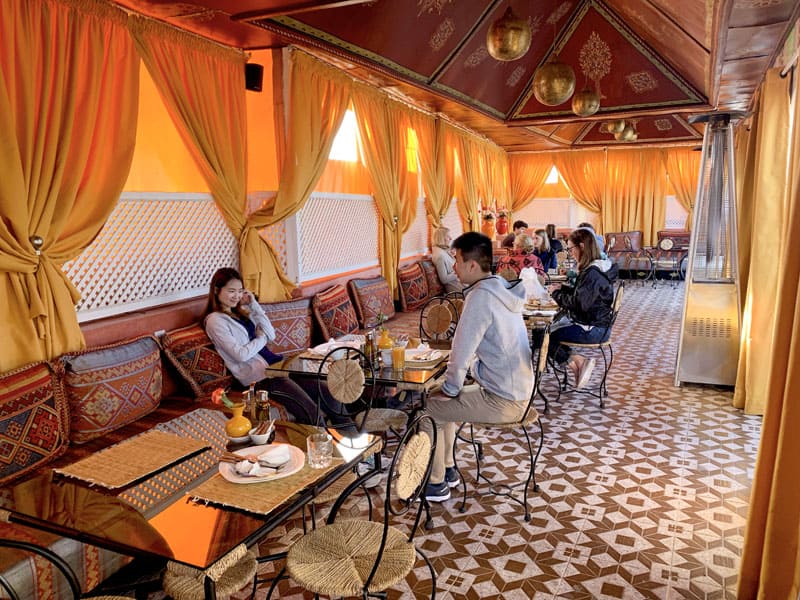
Marrakesh Hotels
There are two basic types of hotels in Morocco: a Riad and a Dar. They are restored/renovated Moroccan houses and are essentially the same, both form- and function-wise.
A riad, though, will have an interior garden (riad is Arabic for “garden”) and a dar an interior courtyard, with a tree or two, often with a fountain. In some riads (perhaps in dars also, but I can’t say for sure) the garden has been replaced with a small pool that’s for esthetics only, not for swimming.
Essentially, riads and dars are B&Bs, and since they are former homes, room windows face into the interior courtyard and not outside, which is the Islamic tradition.
You may also enjoy: Top 10 Things To Do In Morocco / Goats in a Tree in Morocco (Video) / Camel Trekking Across the Sahara in Morocco (Video)
That was the case at Riad Challa, our hotel in the Medina, when we stayed in Marrakesh. It was about $100 per night, including a great breakfast up on the rooftop. It receives mixed reviews on TripAdvisor, although the majority are excellent.
You’ll find plenty of similar riads all about the Medina.
One critical point: since traffic is banned in the Medina, if you arrive by taxi, you’ll be left outside one of the city’s gates with your luggage. From there, you’ll need to find your way to your hotel.
For most foreigners, that’s basically impossible in such an ancient city where there are very few signs as to what lies behind each nondescript doorway. The solution is to have your tour guide bring you to your hotel or arrange with the hotel to meet you at the gate.
That’s what we did in Marrakesh; our guide parked the car and led us to our hotel. There was no way we would have found it otherwise.
If you’re looking to book a riad or dar, try to find one near one of the city’s eight main gates or one of the several minor ones, so you don’t have to drag your luggage too far.
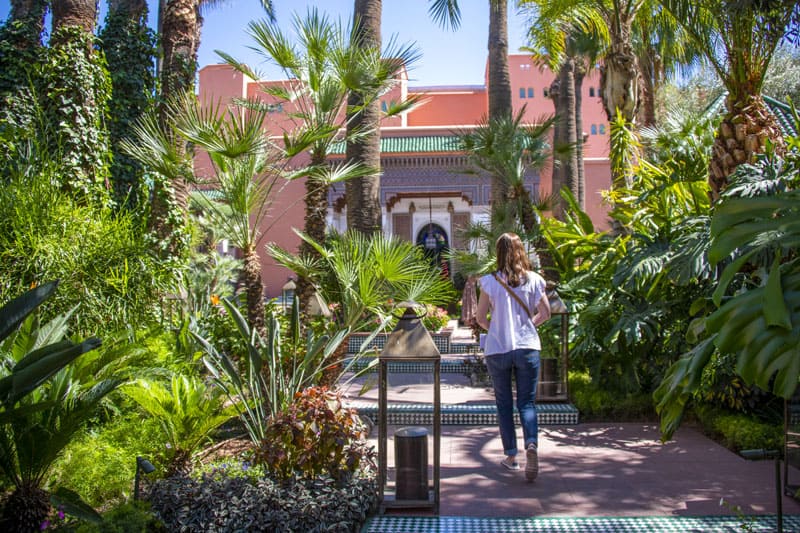
You’ll also find several luxury hotels in Marrakesh, including the spectacular five-star La Mamounia. One of its most famous guests was Winston Churchill, who much enjoyed painting as a hobby. He used to vacation in Marrakesh because of the scenery and climate, neither of which he could find in his native Britain.
They usually don’t allow non-guests into the hotel, but we talked our way in to get a glimpse of the beautiful open garden area, pools, tennis courts, and high-end shopping.
If you’re looking for something lux a bit closer to the Jemaa-el-Fna, try Les Jardins De La Koutoubia, which is a few minute’s walk from the evening show.
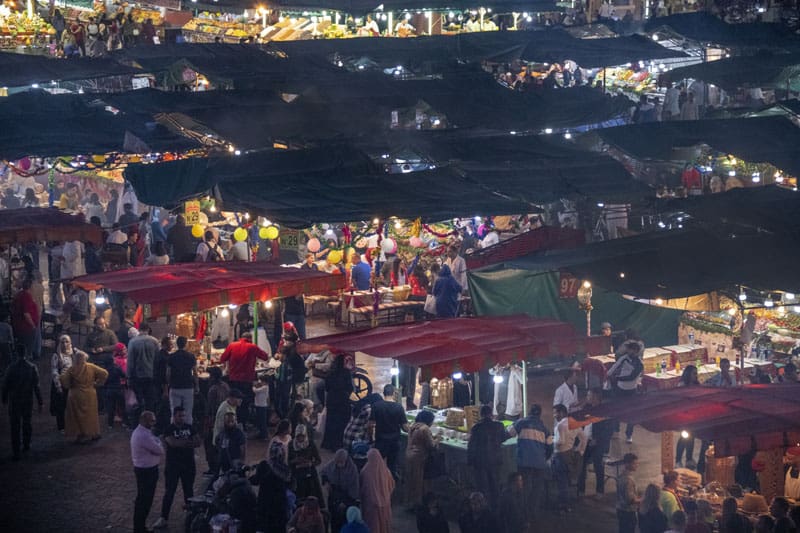
Moroccan Food
One of the pleasures of traveling to Morocco, especially to Marrakesh, is the food, which is a blend of 30+ spices and herbs. Served in a wide range of styles and surroundings, it’s a treat.
The traditional Berber dish is tagine, a slow-cooked aromatic stew of meat (most often lamb or chicken) or fish with vegetables. “Tagine” is also the name of the conical earthenware pot that it comes in.
The Jemaa-el-Fna is a foodie’s heaven with an incredible number of food stands selling a near-uncountable selection of Moroccan dishes. If you’re new to Moroccan food, you may want to start here and try a little of everything…kababs, tagines, salads, vegetables, couscous, etc.
Perhaps also begin your taste-testing in mid-afternoon before the evening crowds descend on the square. Then you’ll have time to chat with the stand owners to discover what you’ll like best.
And, of course, you can always spend a few evenings restaurant-hopping in Ville Nouvelle.
And one last note about the spelling of Marrakesh. If you’re confused about the spelling – Marrakesh vs. Marrakech – the word with the “s” is the English spelling. “Marrakech” is the French spelling used in France, Spain, and some other European countries.

Leave a Reply